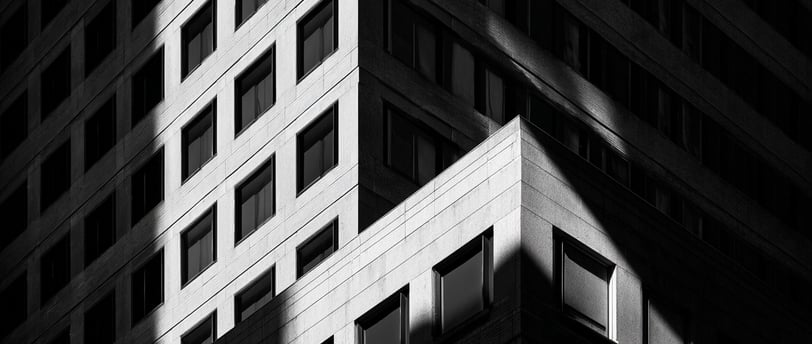Discover Art for Every Space — From Collector Prints to Curated Digital Downloads
What Makes a Good Black and White Architectural Photograph?
BLACK AND WHITE PHOTOGRAPHY INSIGHTS
Gary Washington
3 min read


The Art of Seeing in Monochrome
A great black and white photograph doesn't begin with your camera. It starts with how you see. In architectural photography, success depends on your ability to look past color and focus on structure, contrast, and emotion.
In the absence of color, your subject must speak through shape, texture, and lighting. The building becomes the message. Your job is to frame it clearly.
Key Elements of a Powerful Monochrome Image
1. Strong Composition
Without color to guide the eye, composition becomes everything. Use leading lines, symmetry, and framing to draw the viewer into the image.
Look for:
Repeating patterns in windows or bricks
Angles and lines that lead toward a focal point
Negative space that adds balance and breathes
A well-composed black and white architectural image should feel structured yet expressive.
2. Intentional Lighting and Shadow Play
Light in black and white photography isn’t just a technical necessity — it’s the emotional language. Shadows create drama. Highlights sculpt form.
Tips:
Shoot during golden hour or overcast days for soft directional light
Look for harsh shadows under stairwells or arches for contrast
Use reflections or backlighting to add layers
The interplay between shadow and light should feel deliberate, not accidental.
3. Texture and Detail
Color can distract from the finer textures of a building — like peeling paint, exposed concrete, or aged stonework. A great black and white image invites viewers to almost feel the materials.
Zoom in on:
Worn stone patterns
Metallic surfaces with reflections
Intricate ceiling designs or columns
These details build a sense of place and permanence.
Common Mistakes That Weaken a Monochrome Photo
Even talented photographers miss the mark when certain elements are overlooked. Here are a few pitfalls:
Flat lighting: If there’s no difference between the subject and background, the photo loses depth.
Too much contrast: Cranking up the contrast doesn’t make a photo more dramatic — it often kills the subtleties.
Over-cluttered compositions: Without color, too many shapes or elements can overwhelm the frame.
Poor tonal range: Great black and white images show a smooth gradient from black to white — not just pure extremes.
Architectural Photography Tips for Black and White Artists
To elevate your work (or train your eye as a collector), here are techniques professionals use:
Use manual mode to control exposure and capture detail in highlights and shadows
Preview your shots in black and white (many cameras have monochrome preview settings)
Bracket exposures for HDR merging later if dynamic range is tricky
Use a tripod for precision in framing and long exposure shots of buildings or interiors
Each photo should tell a story through structure and silence.
From Good to Gallery-Worthy: The Collector’s View
Buyers and collectors may not always know the technical reasons why a photo feels powerful — but they can sense when it’s done right.
What adds value in the eyes of a collector:
Unique subject matter not found in mass-market prints
Clean, intentional framing
Subtle, thoughtful editing
Printable quality at large scale
A signature style that makes the piece recognizable
When a black and white architectural photograph blends mood, design, and story — it transforms from a snapshot into artwork.
Real Examples from the Artist’s Eye
Let’s break it down with examples from our collection:
The Stairwell — A single beam of light illuminates the edge of the spiral. The contrast and negative space add movement.
Urban Stillness — A brutalist wall at dawn. The texture of the concrete creates quiet tension.
Skyline Minimal — A skyline abstracted into simple shapes and lines. The city becomes sculpture.
Each piece isn’t just decorative. It’s designed to make the viewer pause.
Final Thoughts: The Difference Is in the Details
So, what makes a good black and white photograph? It’s not just technique. It’s restraint. It’s the ability to let structure, shadow, and stillness do the talking.
In architectural photography, this means honoring the geometry and rhythm of design — while still allowing emotion to surface through simplicity.
Whether you're photographing buildings or searching for the perfect print, the best images are the ones that feel both precise and poetic.
Want to See These Principles in Action?
Explore our curated gallery of black and white architectural prints — designed for collectors, creatives, and lovers of structure.
To learn about color comparisons, visit Is Black and White Photography Better Than Color? A Photographer’s Honest Answer.
Mr. Washington Gallery
Mr. Washington Gallery showcases striking black and white architectural photography and fine art prints. Rooted in timeless design and thoughtful composition, each piece invites reflection, storytelling, and a deeper connection to the built world.
Quick links
© 2025. All rights reserved.
